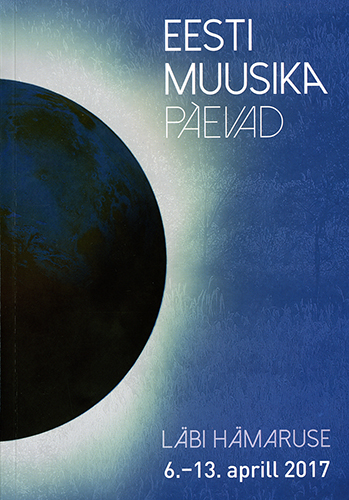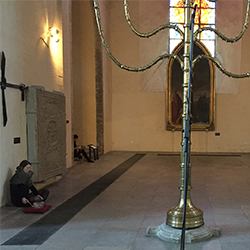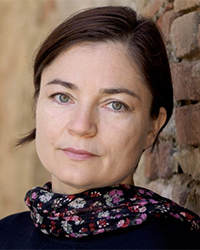 In the previous part, i remarked on Estonian music’s apparent distance from compositional developments of the twentieth and twenty-first centuries. And while i also remarked that i don’t believe it’s happening in a vacuum, it is demonstrably removed from many of the attitudes that one tends to take for granted in western Europe, and one of the great positives of this is a surprisingly unconventional approach to the presentation of new music. In this respect, to say that the Estonian Music Days is no ordinary music festival is to put it absurdly mildly: they’re prepared to take real risks yet to do so in a relaxed, carefree way in which creative intent is matched with a sanguine attitude of “what happens, happens”.
In the previous part, i remarked on Estonian music’s apparent distance from compositional developments of the twentieth and twenty-first centuries. And while i also remarked that i don’t believe it’s happening in a vacuum, it is demonstrably removed from many of the attitudes that one tends to take for granted in western Europe, and one of the great positives of this is a surprisingly unconventional approach to the presentation of new music. In this respect, to say that the Estonian Music Days is no ordinary music festival is to put it absurdly mildly: they’re prepared to take real risks yet to do so in a relaxed, carefree way in which creative intent is matched with a sanguine attitude of “what happens, happens”.
Modestly unconventional was the ‘meditation’ conceived by Helena Tulve that preceded Thursday evening’s choral concert by Vox Clamantis (reviewed in Part 1). Lasting thirty minutes, this began as we were entering the Niguliste church, and at first was almost unnoticeable, the four performers (including Tulve and fellow composer Tatjana Kozlova-Johannes) sitting at the four corners of the entrance, each nonchalantly and very softly striking the edge of a glass bowl. What was very clear from the start was that, although aspects were indeterminate, the specific pitches used had been carefully selected (after the concert i noticed that every bowl had a sticker in the bottom giving its precise pitch, including cent deviations). The opening oscillated around the interval of a slightly microtonal minor third which persisted as the players began to move down the nave – joined by a fifth performer whose actions were equal parts music and dance – sliding marbles in their respective bowls, initially barely agitating them, creating a constantly-changing yet static pitch cluster. Having moved to stand at the four corners of the audience in front of tables filled with many more bowls, the pitch range now greatly expanded, still sounding indeterminate yet with a sense of finity, stretching the previously-established stasis.
 The music became a study in both density and harmony, the texture nicely complicated by the dancer moving down the centre dragging a marble around the outside of her bowl. Eventually they moved on again, ending up at the front of the church, the pitches by now emphasising a minor ninth and almost sounding electronic, a notion that was reinforced when they moved out of sight behind the altarpiece and began to bow the bowls, creating an amazingly beautiful cluster that finally coalesced on a single pitch, from which the first choral piece in the concert (Galina Grigorjeva’s Vespers) now emerged. This was a truly stunning performance that has remained with me constantly since, music created from the most simple means but carefully managed to create engrossing slowly-evolving forms (at times bringing Kenneth Kirschner’s work strongly to mind). Rapturously lovely, and a perfect way to prepare the space and the audience for the music to follow.
The music became a study in both density and harmony, the texture nicely complicated by the dancer moving down the centre dragging a marble around the outside of her bowl. Eventually they moved on again, ending up at the front of the church, the pitches by now emphasising a minor ninth and almost sounding electronic, a notion that was reinforced when they moved out of sight behind the altarpiece and began to bow the bowls, creating an amazingly beautiful cluster that finally coalesced on a single pitch, from which the first choral piece in the concert (Galina Grigorjeva’s Vespers) now emerged. This was a truly stunning performance that has remained with me constantly since, music created from the most simple means but carefully managed to create engrossing slowly-evolving forms (at times bringing Kenneth Kirschner’s work strongly to mind). Rapturously lovely, and a perfect way to prepare the space and the audience for the music to follow.
While the audience clearly found this piece as mesmerising as i did, it was occasionally apparent elsewhere at the EMD that Estonians are not always open to less conventional acts of musical expression. At Friday night’s orchestral concert in the Estonia Concert Hall (review here), Timo Steiner‘s new work for piano and orchestra And then leave everything you’ve got and go… involved such a relentlessly inverted and diffident mode of performance from the pianist in conjunction with a deliberately unclear relationship between soloist and orchestra – the former seemingly detached entirely from the machinations of the latter – that it clearly pushed some people well beyond their tolerance. Along with Liisa Hirsch‘s marvellous harmony/texture study Threshold, which began the concert, Steiner’s piece was a world away from the conventions of Estonian music encountered elsewhere. The startling rudeness of some members of the audience during this bravely provocative new work – laughing, whispering, checking their phones – left one in absolutely no doubt that Steiner was doing everything right. Estonia could do with a lot more of this.
 Steiner’s intentions had a distinct and really rather moving hauntological quality, as did the very first piece i encountered at this year’s EMD, Listening Stone by Tammo Sumera (son of Lepo). Having placed microphones at various points both in the vicinity of Niguliste church as well as inside it (where Vox Clamantis were rehearsing), Sumera channelled their live output, together with some processing and overlaying of previously recorded sounds, through a collection of loudspeakers placed around the outside of the church building. This resulted in a wonderfully multilayered sonic fabric, melding ambient and industrial noises and the sounds of people – talking, laughing, walking – with fragmentary swatches of choral music. Emanating from the speakers, this created the rather wondrous effect of the church itself radiating outwards aural memories from throughout its 800-year history, seamlessly blending with the ‘real’ (i.e. not captured) sounds happening at the same time around the building. A very telling piece that became increasingly immersive the longer one spent time with it.
Steiner’s intentions had a distinct and really rather moving hauntological quality, as did the very first piece i encountered at this year’s EMD, Listening Stone by Tammo Sumera (son of Lepo). Having placed microphones at various points both in the vicinity of Niguliste church as well as inside it (where Vox Clamantis were rehearsing), Sumera channelled their live output, together with some processing and overlaying of previously recorded sounds, through a collection of loudspeakers placed around the outside of the church building. This resulted in a wonderfully multilayered sonic fabric, melding ambient and industrial noises and the sounds of people – talking, laughing, walking – with fragmentary swatches of choral music. Emanating from the speakers, this created the rather wondrous effect of the church itself radiating outwards aural memories from throughout its 800-year history, seamlessly blending with the ‘real’ (i.e. not captured) sounds happening at the same time around the building. A very telling piece that became increasingly immersive the longer one spent time with it.
But the most outlandishly radical event at this year’s EMD was one that not only would likely not happen in the UK, but would in all probability have come up against so many asinine legal/ethical barriers that it wouldn’t even be possible. Called Obscure Avenues, it involved a short bus drive to a nearby building where we were led to various locations wherein a collection of electronic and acoustic pieces were played; we were then led back to the bus for the return journey. This all lasted a little under two hours, and for the entire thing we were blindfolded. As listeners, we’re very used to – take for granted in fact – the idea that concert-going is a deliberate, organised and above all, very personal choice. Of course, we remain open to the unexpected that always occurs at any musical event (no genuine fan of contemporary music fears the unexpected – quite the opposite), but deciding what, whom and where we want to engage are fundamental choices within the act of concert-going. Aside from the most basic decision of whether to go through with it or not, Obscure Avenues stripped away all of that personal autonomy. This was not an insignificant challenge, and many (perhaps most) people would likely lack the courage, trust and openness to embrace such a total relinquishment of control. Yet, encouragingly, the bus was full: both literally and figuratively we were in for a remarkable ride.
 We were led from place to place with infinite care, the slightest of hand and arm gestures guiding us down, up, around and along the stairs and passageways to and from whatever building we went to. Being unable to see anything at all, this experience in itself was enthralling, the movement between being inside – the bus, the building – and in the open air, whereupon the light and warmth of the sun become suddenly apparent. Some of the music was encountered while on the move, improvisations on percussion and electronics by Le Quan Ninh and Taavi Kerikmäe (Kerikmäe conceived the entire experience). The building we were in clearly had an industrial aspect, and the duo’s improvising made the most of this, occupying a metallic soundworld with overt splashy crashes and light and heavy impacts that seemed to scamper rapidly all around us. i still don’t know to what extent this was happening live and/or via a recording (the rapidity of some of the movements makes the latter seem more likely), but this uncertainty only made it all the more fantastical. At two points we sat to listen, first to a four-channel electronic piece by Kerikmäe called Vibratings and Vibrations 2, a work heavily redolent of ’50s and ’60s analogue cut-and-splice electronics, which was nicely handled and in the obviously metallic space within which it played out, sounded excellent. Elsewhere we heard Helena Tulve‘s Heart of the Earth, a work that in both its instrumentation and material owes a clear debt to Boulez’s Derive 1, the music dominated by trills and tremolandi; the volte face of the work’s conclusion was so enormous one wondered initially if it was in fact a different piece, Tulve stilling the ensemble into a much more restrained and introverted soundworld so exquisitely delicate that one almost wanted it never to end. i should stress that we didn’t know what we had heard until the end of the event, leaving the bus, when were given all of the details: black text on black cards, which i’ve literally just read before writing these words. (i liked the not knowing, but credit where credit’s due.) Obscure Avenues was easily one of the most riveting and memorable experiences of my life, music comprising only one aspect of its much broader challenge to our engagement with space and sound (the blindfolds were essential: without them it would have been entirely meaningless); each day since my mind has sent me back there into that profound darkness of unknowing. Kudos to the Estonian Music Days for being prepared to put on such a radical event (which must have been a logistical nightmare) and for presenting it with complete faith and conviction. Here was proof positive of Estonian music’s capacity to break every convention and take audiences somewhere utterly new.
We were led from place to place with infinite care, the slightest of hand and arm gestures guiding us down, up, around and along the stairs and passageways to and from whatever building we went to. Being unable to see anything at all, this experience in itself was enthralling, the movement between being inside – the bus, the building – and in the open air, whereupon the light and warmth of the sun become suddenly apparent. Some of the music was encountered while on the move, improvisations on percussion and electronics by Le Quan Ninh and Taavi Kerikmäe (Kerikmäe conceived the entire experience). The building we were in clearly had an industrial aspect, and the duo’s improvising made the most of this, occupying a metallic soundworld with overt splashy crashes and light and heavy impacts that seemed to scamper rapidly all around us. i still don’t know to what extent this was happening live and/or via a recording (the rapidity of some of the movements makes the latter seem more likely), but this uncertainty only made it all the more fantastical. At two points we sat to listen, first to a four-channel electronic piece by Kerikmäe called Vibratings and Vibrations 2, a work heavily redolent of ’50s and ’60s analogue cut-and-splice electronics, which was nicely handled and in the obviously metallic space within which it played out, sounded excellent. Elsewhere we heard Helena Tulve‘s Heart of the Earth, a work that in both its instrumentation and material owes a clear debt to Boulez’s Derive 1, the music dominated by trills and tremolandi; the volte face of the work’s conclusion was so enormous one wondered initially if it was in fact a different piece, Tulve stilling the ensemble into a much more restrained and introverted soundworld so exquisitely delicate that one almost wanted it never to end. i should stress that we didn’t know what we had heard until the end of the event, leaving the bus, when were given all of the details: black text on black cards, which i’ve literally just read before writing these words. (i liked the not knowing, but credit where credit’s due.) Obscure Avenues was easily one of the most riveting and memorable experiences of my life, music comprising only one aspect of its much broader challenge to our engagement with space and sound (the blindfolds were essential: without them it would have been entirely meaningless); each day since my mind has sent me back there into that profound darkness of unknowing. Kudos to the Estonian Music Days for being prepared to put on such a radical event (which must have been a logistical nightmare) and for presenting it with complete faith and conviction. Here was proof positive of Estonian music’s capacity to break every convention and take audiences somewhere utterly new.

[…] venue, encountering assorted performances along the way (excellent examples have taken place at the Estonian Music Days 2017, Only Connect 2018 and Forum Wallis 2019). On this occasion it was the Helena Modrzejewska National […]